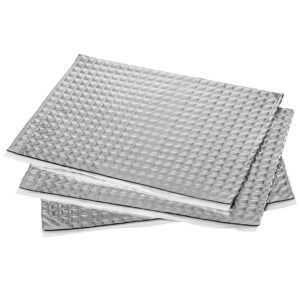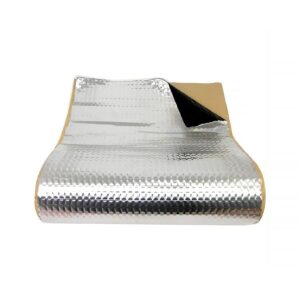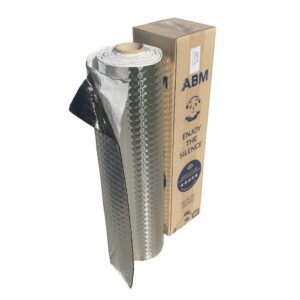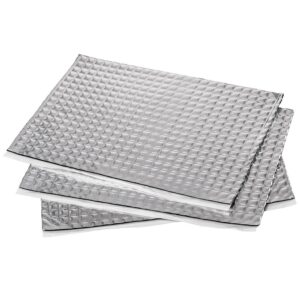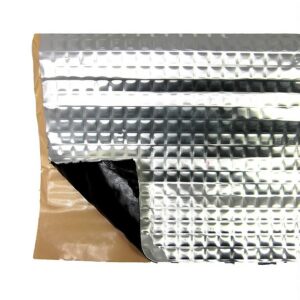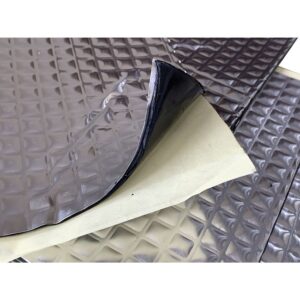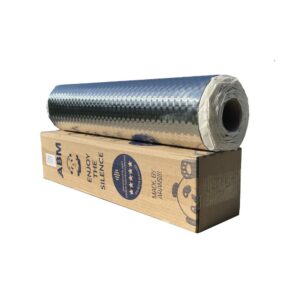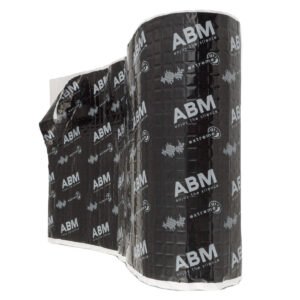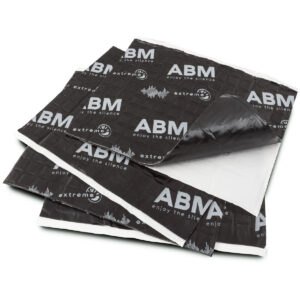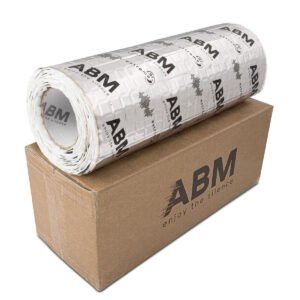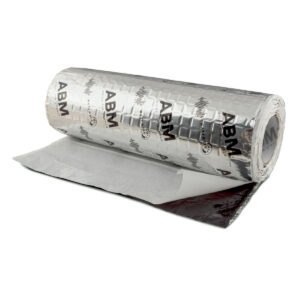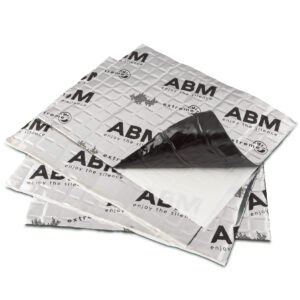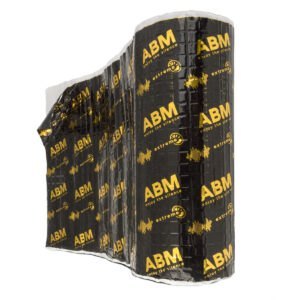Modern life brings constant exposure to noise. Especially while driving, the human body experiences prolonged acoustic stress. Engines, tires on asphalt, and body vibrations create a mixture of sounds often exceeding safe health standards. Regular travel in a noisy vehicle can lead to permanent hearing damage.
Butyl soundproofing mats provide an effective barrier against harmful road noise. The special material structure absorbs sound waves and eliminates vehicle structural vibrations. Properly installed soundproofing systems can reduce cabin noise levels by up to 15 decibels. This difference is sufficient to lower the risk of hearing damage during daily trips.
Hearing protection while driving is not just a matter of comfort. Chronic exposure to noise above 85 decibels can lead to irreversible hearing loss. Many drivers are unaware of this risk. Installing butyl mats in a vehicle is a proactive investment in the long-term hearing health of the entire family.
What Are Butyl Mats and How Do They Work in Car Soundproofing
Butyl mats consist of two key layers. The base is made of high-density flexible butyl mass. The second layer includes an aluminum coating made from genuine cold-rolled metal. The combination of these components creates an effective barrier against noise and vibrations. The self-adhesive layer facilitates installation without the need for additional tools or materials.
Modern butyl mats have replaced older bituminous solutions due to better performance properties. Unlike bituminous materials, butyl does not crack or crumble under varying temperatures. Its flexible structure remains stable within a range from -50°C to +175°C. The material’s durability translates into long-term soundproofing effectiveness without the need for replacement after several years of use.
Construction and Properties of Butyl Mats
The butyl layer of the mats forms the core of the damping system. Synthetic butyl rubber is characterized by exceptional vibration energy absorption capacity. The material’s flexible molecular structure allows effective conversion of mechanical energy into heat. This process eliminates unwanted vibrations and associated noises.
The aluminum coating serves a dual function in the soundproofing system. The first involves reflecting part of the sound waves back, which enhances acoustic insulation effectiveness. The second function concerns thermal insulation—aluminum blocks heat flow between the surface and the vehicle interior. The thickness of the aluminum layer in high-quality mats is 100 microns, providing an optimal balance between flexibility and effectiveness.
Key technical parameters of butyl mats:
- Material density: from 2.1 to 4.8 kg/m² depending on thickness
- Bond strength with metal: minimum 15 MPa
- MLF sound damping coefficient: 0.38
- Chemical resistance: oils, fuels, solvents
- Safety certifications: PIMOT, DEKRA, RoHS
The values of the technical parameters directly affect the effectiveness of vehicle soundproofing. A higher MLF coefficient means better vibration energy absorption by the material. Safety certifications guarantee that the mats do not emit harmful substances under operating conditions.
Vibration absorption mechanism of butyl material
The vibration damping process by butyl mats is based on three main physical mechanisms. The first involves the absorption of vibrational energy by the elastic structure of butyl. When sound waves reach the surface covered with the mat, the material deforms and absorbs part of the mechanical energy. The energy is then converted into heat and dissipated within the mat’s structure.
The second mechanism concerns damping of vehicle structural resonances. Butyl mats increase the mass and stiffness of the surfaces to which they are applied. This parameter change shifts resonance frequencies beyond the range of typical engine and chassis vibrations. The effect is especially noticeable in eliminating low frequencies, which are the hardest to dampen with traditional methods.
The third element involves scattering vibration energy at the contact surface between the mat and structural component. The self-adhesive layer ensures full adhesion of the material to the substrate. The absence of gaps or voids eliminates vibration transmission through the connection. The result is effective acoustic insulation operating across a wide frequency range.
Differences between butyl mats and traditional insulation materials
Bituminous materials, popular in the past, show significant limitations compared to modern butyl mats. The first difference concerns performance under varying temperatures. Bitumen loses damping properties already at 186°F (86°C), while butyl remains effective even at 219°F (104°C). The efficiency difference ranges from 60-72% in favor of butyl mats at high temperatures.
The second important difference relates to material durability. Bituminous mats tend to age and degrade over time. They harden, lose elasticity, and crack. Cracks allow moisture penetration under the mat, which can lead to body corrosion. Butyl mats maintain elasticity and tightness for many years of use without visible signs of degradation.
| Parameter | Butyl Mats | Bituminous Materials |
|---|---|---|
| Operating Temperature | -50°C to +175°C | -20°C to +86°C |
| Installation | No heating required | Heating required |
| Durability | Over 10 years | 3-5 years |
| Moisture Resistance | Total | Limited |
The ease of installation is another advantage of butyl mats over traditional solutions. Bituminous materials require heating with a heat gun to achieve the flexibility needed for application. This process extends working time and requires additional tools.
Effectiveness of Butyl Mats in Reducing External Noise
Butyl mats demonstrate high effectiveness in eliminating various types of road noise. Studies show that professionally installed soundproofing systems can reduce noise levels inside the vehicle cabin by 3-7 decibels more than traditional materials. The difference is especially noticeable with low-frequency sounds, which are the hardest to eliminate using standard acoustic insulation methods.
The effectiveness of butyl mats in noise reduction depends on several key factors. The first concerns the thickness of the material used—thicker mats provide better damping but increase the vehicle’s weight. The second factor involves the coverage area—the larger the area covered with mats, the better the acoustic effect. The third element relates to installation quality—proper surface preparation and elimination of air bubbles are crucial for the final result.
ABM Professional butyl mats feature a sound damping coefficient MLF of 0.38. This parameter defines the material’s ability to absorb vibration energy and convert it into heat. In practice, this translates into effective noise reduction across a wide frequency range. The mat structure ensures even damping of both airborne noise and structural vibrations transmitted through body components.
Reduction of Decibel Levels Inside the Vehicle Cabin
The typical noise level inside a vehicle cabin while driving on a highway ranges from 70 to 80 decibels. This value exceeds recommended limits for prolonged exposure, which are a maximum of 65 dB for 8 hours daily. Properly installed butyl mats can lower this level to a safe range of 55-65 dB, significantly reducing the risk of hearing damage.
The noise reduction effect is not uniform across all sound frequencies. Butyl mats most effectively eliminate sounds in the 100-1000 Hz range, corresponding to engine and drivetrain noise. High frequencies, such as tire rustling or wind noise, require additional absorbing materials. Low frequencies below 100 Hz are the hardest to eliminate and require thicker mats or combinations of different materials.
Typical Noise Sources in a Vehicle:
- Internal combustion engine: 65-75 dB
- Tires on asphalt: 60-70 dB
- Wind at 62 mph (100 km/h): 55-65 dB
- Exhaust system: 70-80 dB
- Body vibrations: 50-60 dB
Identifying main noise sources allows optimal placement of butyl mats in the vehicle. The most intense sources require thicker mats and greater coverage area.
Impact on Eliminating Structural Body Vibrations
Structural body vibrations are a significant source of noise in a vehicle. They arise from engine operation, road surface irregularities, and vehicle aerodynamics. Butyl mats eliminate these phenomena by increasing mass and damping the resonance points of the structure. The effect is especially noticeable in eliminating booming and vibrations transmitted through chassis components.
The mechanism of damping structural vibrations is based on changing the dynamic parameters of the surface. Applying a butyl mat increases the mass of the element and changes its stiffness. These parameters affect the natural frequency of vibrations, shifting it beyond the range of typical excitations. The result is a significant reduction in vibration amplitude and associated structural noise.
The most effective locations for mat installation include areas with the largest surface area and tendency to vibrate. These include the cabin floor, center tunnel, doors, and vehicle roof. Covering surfaces with butyl mats of appropriate thickness can eliminate most structural vibrations. The effect is particularly noticeable when driving on uneven surfaces and when the engine is idling.
Comparison of Effectiveness of Different Thicknesses of Butyl Mats
The thickness of butyl mats directly impacts noise damping effectiveness. Thin mats with a thickness of 1.5 mm are suitable for soundproofing lightweight elements such as the hood or trunk lid. Medium thicknesses of 2-2.5 mm are optimal for doors and side panels. The thickest mats, 3 mm, are used in areas with the most intense noise, such as the cabin floor or wheel arches.
Increasing mat thickness from 1.5 mm to 3 mm doubles its mass from 2.1 kg/m² to 4.8 kg/m². Mass influences damping effectiveness according to the mass law. Heavier materials more effectively block sound transmission. However, increasing mass leads to higher fuel consumption for the vehicle. An optimal solution requires finding a compromise between acoustic effectiveness and practical limitations.
Recommended Thicknesses of Butyl Mats:
- Engine hood: 1.5 mm (optimal damping with low mass)
- Vehicle doors: 2 mm (balance between effectiveness and mass)
- Cabin floor: 2.5-3 mm (maximum damping of heavy vibrations)
- Roof: 2.5 mm (reduction of rain and hail noise)
- Trunk lid: 1.5 mm (elimination of vibrations when closing)
Proper selection of mat thickness for specific applications maximizes acoustic effect while minimizing impact on vehicle weight. Thinner mats suffice for elements with small surface area and low vibration activity.
Optimal Vehicle Surface Coverage for Maximum Noise Reduction
The effectiveness of vehicle soundproofing depends not only on the quality of butyl mats but also on their application strategy. Covering 30-50% of a given element’s surface often suffices to achieve satisfactory acoustic results. Full surface coverage provides little improvement while significantly increasing costs and weight. The key is identifying areas with the highest vibration activity and prioritizing their coverage with mats.
The optimal installation strategy begins with measuring noise levels at various points in the vehicle. Areas with the highest sound intensity require priority application of butyl mats. Typically, these are the central areas of large surfaces where vibration amplitude reaches its maximum. Edges and corners of components often show less vibrational activity and can remain uncovered without significant loss of effectiveness.
Proper installation also requires considering the direction of vibration propagation within the vehicle structure. Butyl mats should be applied where vibrations pass from one component to another. Interrupting vibration transmission paths is often more effective than covering the entire surface of a component. This strategy allows for maximizing acoustic effect with minimal material usage.
Tip: Before installing butyl mats, conduct a vibration detection test by placing your hand on various surfaces while the engine is running. Areas with the strongest vibrations require priority coverage with mats.
Hearing Protection During Long-Distance Driving
Prolonged exposure to noise while driving poses a serious threat to hearing health. Professional drivers who spend several hours daily in a vehicle are especially at risk of gradual hearing loss. The issue also affects frequent business travelers and families regularly taking long vacation trips. Noise levels of 70-80 decibels, typical inside a car driving on the highway, can cause hearing damage after many hours of exposure.
The harmful effects of road noise are cumulative. Damage builds up gradually due to years of exposure. Early symptoms include auditory fatigue after long drives and difficulty hearing high-pitched sounds. In advanced stages, permanent hearing loss may occur in certain frequency ranges. Hair cells responsible for detecting sounds between 3000-6000 Hz—critical for speech comprehension—are particularly vulnerable to damage.
Butyl mats provide an effective method for preventing hearing damage related to driving. Reducing noise levels by 10-15 decibels significantly extends safe exposure time, allowing drivers to undertake long journeys without risking hearing loss. Additionally, a quieter vehicle interior reduces fatigue and improves concentration while driving.
The Impact of Chronic Road Noise Exposure on the Auditory System
Chronic exposure to road noise causes gradual degradation of auditory structures. The first stage involves damage to outer hair cells in the cochlea of the inner ear. These cells are responsible for amplifying weak sounds and precise frequency analysis. Their damage leads to reduced hearing sensitivity and impaired discrimination of sounds with similar frequencies.
Prolonged exposure to noise can also cause damage to the inner hair cells, which are responsible for transmitting signals to the auditory nerve. The damage is irreversible and leads to permanent hearing loss. The process is painless and often goes unnoticed, causing exposed individuals to be unaware of the progressing damage until significant hearing problems occur.
Stages of noise-induced hearing damage:
- Temporary threshold shift (reversible after rest)
- Permanent damage around 4000 Hz (first warning sign)
- Expansion of damage to speech frequencies (2000-3000 Hz)
- Progressive hearing loss across a wide range of frequencies
- Significant difficulties in understanding speech, especially in noisy environments
The early stage of hearing damage often remains unnoticed by those exposed. Regular audiometric testing allows for the detection of initial symptoms and the implementation of preventive measures.
Benefits of noise reduction for the health of drivers and passengers
Reducing noise inside the vehicle cabin provides multifaceted health benefits beyond just hearing protection. A quieter environment lowers stress levels and reduces the release of stress hormones such as cortisol and adrenaline. This effect is particularly important during long trips when the body is exposed to chronic acoustic stress. Lower stress levels translate into better well-being and a reduced risk of cardiovascular diseases.
Improved communication quality is another significant benefit of vehicle soundproofing. In a quieter cabin, conversations among passengers are clearer and do not require raising voices. This is especially important for families with young children who are more sensitive to noise. Better acoustic conditions also enhance the quality of phone calls made through hands-free systems, increasing communication safety while driving.
Noise reduction also affects the quality of passengers’ sleep during long journeys. A quieter vehicle interior allows for restorative rest, which is especially important during family trips. Children and elderly individuals are particularly sensitive to noise and may have difficulty falling asleep in noisy environments. Soundproofed vehicles provide better conditions for rest during stops and while riding as a passenger.
The importance of silence in the cabin for concentration while driving
Noise inside the vehicle cabin negatively impacts the driver’s cognitive abilities. Studies show that noise levels above 70 decibels can reduce concentration and lengthen reaction times to dangerous situations. This effect is especially noticeable during monotonous highway drives when the driver must maintain alertness for several hours. Reducing noise to levels between 55-65 decibels significantly improves driving comfort and travel safety.
A quiet cabin allows better hearing of external sounds that may signal danger. Sirens from emergency vehicles, horn signals from other road users, and sounds indicating technical problems with the vehicle are more clearly audible in a soundproofed interior. Paradoxically, reducing internal noise improves perception of important external sounds, enhancing the driver’s situational awareness.
Noise reduction also affects the performance of voice recognition and navigation systems. Modern vehicles equipped with advanced multimedia systems operate much more effectively in a quiet cabin. Better recognition of voice commands reduces the need to divert attention from the road to operate vehicle systems. This effect directly translates into improved driving safety.
Tip: Regular breaks every 2 hours allow for auditory rest even in a well-insulated vehicle. A short walk in a quiet environment helps regenerate tired auditory structures.
Installation locations for butyl mats for optimal sound insulation
The effectiveness of vehicle soundproofing largely depends on the strategic selection of installation locations for butyl mats. Different areas of the vehicle require different approaches due to the nature of the noise generated and operating conditions. Professional installation requires analysis of vibration transmission paths and identification of main noise sources. Optimal surface coverage allows achieving maximum acoustic effect with rational material usage.
The soundproofing strategy should consider the hierarchy of importance of various vehicle areas. The cabin floor and center tunnel are the most important locations due to their direct contact with the drivetrain. Vehicle doors require special attention because of their complex construction and presence of mechanisms. The roof and trunk lid, although less critical, can significantly affect acoustic comfort during driving in rain or hail.
The process of installing butyl mats requires thorough surface preparation and precise application of the material. Surfaces must be clean, dry, and degreased before applying mats. Eliminating air bubbles and ensuring full adhesion is crucial for effective soundproofing. Improperly installed mats can generate additional noise in the form of clicks or vibrations from loosely attached material.
Soundproofing the floor and center tunnel
The cabin floor is the most important area for soundproofing due to its direct contact with the vehicle’s drivetrain. Vibrations from the engine, gearbox, and exhaust system pass through this surface. The center tunnel, which houses the driveshaft, requires special attention due to high vibration intensity. Using butyl mats 2.5-3 mm thick in these areas can reduce noise levels by 8-12 decibels.
Installing mats on the floor requires removing factory carpets and insulation. The surface must be thoroughly cleaned of glue residues and dirt. Butyl mats should be applied covering areas with the highest vibration activity, mainly central parts of the surface. Special attention should be paid to seat mounting points and structural elements reinforcing the floor.
Key areas for floor soundproofing:
- Middle part of the floor under the front seats
- Center tunnel along its entire length
- Areas above the fuel tank
- Passage points for exhaust system pipes
- Mounting points for chassis components
Proper floor soundproofing also requires consideration of cable and wire passage points. Technological openings must remain unobstructed after applying butyl mats.
Door and side panel insulation
The vehicle doors are a significant source of noise due to their large surface area and complex internal structure. The outer door panels are exposed to direct impact from wind and road noise. The inner door cavities act as resonators, amplifying certain sound frequencies. Using 2 mm thick butyl mats on the outer panels can significantly reduce noise penetration into the cabin.
Installing mats in the doors requires careful removal of upholstery and window mechanisms. Metal surfaces must be thoroughly cleaned and degreased before applying the mats. Special attention should be paid to speaker mounting points and lock mechanisms to avoid interfering with their operation. Mats should be cut while preserving technological and drainage holes.
The vehicle’s side panels, although less critical than the floor, can significantly affect acoustic comfort. Areas behind the side upholstery often resonate during driving, generating unwanted sounds. Applying butyl mats to selected sections of the side panels can eliminate these phenomena. Areas near the wheel arches are especially important, where vibration intensity is highest.
Application on the roof and trunk lid
The vehicle roof requires soundproofing primarily due to atmospheric noise. Raindrops, hail, and strong wind can generate significant noise inside the cabin. Using 2.5 mm thick butyl mats can effectively eliminate these sounds. Additionally, roof soundproofing improves audio system acoustics by eliminating structural resonances.
Installing mats on the roof requires removing the headliner and exposing the metal structure. The roof surface often contains reinforcing ribs and mounting points for equipment components. Butyl mats should be applied between these elements, maintaining ventilation channels and drainage paths unobstructed. Special attention should be given to areas around a sunroof if present in the vehicle.
The trunk lid often generates noise during closing and when driving over uneven surfaces. Applying 1.5–2 mm thick butyl mats can significantly reduce these effects. Soundproofing the lid also improves acoustic quality in the cargo area, which is important for hatchback or station wagon vehicles. Installation requires removing trunk lid upholstery and carefully avoiding lock mechanisms and hinges.
Special applications in the engine compartment
The engine compartment is the main source of mechanical noise in a vehicle. Although direct engine soundproofing is limited due to high temperatures, there are opportunities to apply butyl mats in selected areas. The engine hood, firewall, and side covers of the compartment can be covered with special high-temperature resistant mats.
Applying mats in the engine compartment requires special caution due to the presence of hot components and moving parts. Butyl mats can be safely used on the engine hood, where temperatures do not exceed 100°C. In the case of the fire wall, special care must be taken not to disrupt the operation of the cabin ventilation systems. All materials used in the engine compartment must meet flammability standards for vehicles.
Safe areas for applying mats in the engine compartment:
- Inner side of the hood (temperature up to 100°C)
- Upper part of the fire wall (away from the exhaust manifold)
- Side covers of the engine compartment
- Areas around the radiator (while maintaining air circulation)
- Fuse box cover (if located in the compartment)
The installation of mats in the engine compartment must consider the need for service access to individual systems. Materials must not interfere with the cooling air circulation for the engine.
Tip: Before applying mats in the engine compartment, surface temperatures should be measured after driving several kilometers. A non-contact thermometer will help identify safe areas for installing butyl mats.
Technical parameters and quality standards of butyl mats
The quality of butyl mats determines their effectiveness and durability in soundproofing applications. Key technical parameters include vibration damping coefficient, temperature resistance, and adhesive properties. High-quality mats feature a Material Loss Factor (MLF) of 0.38, ensuring effective vibration energy absorption. This parameter is measured under controlled laboratory conditions according to international acoustic standards.
Quality standards for butyl mats also cover user safety and environmental impact. Certified mats do not contain harmful substances such as aromatic hydrocarbons or heavy metals. Compliance with RoHS standards guarantees safe use within vehicle enclosed spaces. Additionally, mats must meet flammability requirements specified by PN-ISO 3795 for materials used in road vehicles.
The certification process for butyl mats includes a series of laboratory tests conducted by independent institutions. DEKRA tests confirm no emission of toxic substances under operational conditions. PIMOT certificates relate to compliance with Polish automotive safety standards. Technical documentation for high-quality mats should include all certificates and detailed parameter specifications.
Material thickness and vibration damping effectiveness
The thickness of butyl mats directly affects their vibration and noise damping efficiency. Thinner mats with a thickness of 1.5 mm are suitable for application on low-mass components such as hoods or trunk lids. Medium thicknesses of 2-2.5 mm provide an optimal solution for most applications in doors and side panels. The thickest 3 mm mats are intended for soundproofing floors and other areas with high vibration intensity.
Increasing the mat thickness from 1.5 mm to 3 mm doubles its surface mass from 2.1 kg/m² to 4.8 kg/m². Mass affects damping effectiveness according to the acoustic mass law—heavier materials block sound transmission more effectively. However, excessive thickness increases yield diminishing returns with rising costs and impact on vehicle weight. The optimal solution requires adjusting thickness to the specifics of the given application.
| Mat Thickness | Surface Mass | Recommended Application | Noise Reduction |
|---|---|---|---|
| 1.5 mm | 2.1 kg/m² | Hood, trunk lid | 3-5 dB |
| 2.0 mm | 3.4 kg/m² | Doors, side panels | 5-7 dB |
| 2.5 mm | 3.9 kg/m² | Roof, wheel arches | 7-10 dB |
| 3.0 mm | 4.8 kg/m² | Floor, center tunnel | 10-12 dB |
Choosing the appropriate mat thickness requires analyzing the specifics of the given application. Large surface areas and high vibration activity require thicker mats for optimal effectiveness.
Resistance to Weather Conditions and Moisture
Butyl mats must maintain their properties across a wide range of weather conditions encountered during vehicle operation. An operating temperature range from -50°C to +175°C ensures reliable performance in extreme climatic conditions. At low temperatures, the mats remain flexible and do not crack, distinguishing them from older bituminous materials. High temperatures experienced in vehicles left in the sun during summer do not cause the material to soften or deform.
Moisture resistance is a key feature of butyl mats used in vehicles. The material is completely waterproof and does not absorb moisture even with prolonged contact with water. This property prevents the growth of mold and fungi that can develop in damp conditions. Additionally, waterproof mats do not lose adhesion to the substrate even when condensation forms on the vehicle’s body surface.
Butyl Mat Resistance Parameters:
- Operating temperature range: -50°C to +175°C
- Moisture resistance: complete waterproofing
- UV resistance: no degradation for 10 years
- Chemical resistance: oils, fuels, weak acids
- Biological resistance: no mold or fungal growth
The high resistance of butyl mats to external factors guarantees long-term soundproofing effectiveness. The materials retain their damping properties throughout the vehicle’s lifespan without requiring replacement.
Operating Temperature and Adhesion Durability
The adhesive properties of butyl mats must remain stable across the entire temperature range experienced during vehicle operation. The bond strength to metal is at least 15 MPa, ensuring a durable connection even under significant mechanical loads. The self-adhesive layer maintains adhesion both in cold winter temperatures and high summer temperatures found in vehicles.
The adhesion process of butyl mats to metal surfaces involves both chemical and mechanical bonding. The adhesive layer penetrates microscopic surface irregularities, creating a mechanical bond. Simultaneously, chemical reactions occur between the adhesive and metal surface that strengthen the connection. The result is durable adhesion resistant to vibrations, temperature changes, and moisture.
The long-term durability of butyl mat adhesion surpasses competing materials. Aging tests show that properly installed mats retain full adhesion for over 10 years of use. Lack of adhesive degradation and material flexibility prevent delamination even under intense vibrations. This durability translates into long-term soundproofing effectiveness without maintenance requirements.
Tip: Before applying butyl mats, the surface should be degreased with a solvent and then left to dry completely. The optimal installation temperature is 15-25°C, which ensures the best adhesive bonding.
Butyl Mats in the ABM Insulation Store
ABM Insulation Store offers a comprehensive range of high-quality soundproofing materials, specializing in modern acoustic solutions for the automotive, industrial, and construction sectors. The company provides advanced insulation technologies that effectively eliminate noise, vibrations, and thermal issues in various applications.
The product portfolio includes two main lines of butyl mats distinguished by innovative composition and exceptional effectiveness in vibration damping. The products are available in sheets and rolls with various specifications, allowing customization to meet individual customer needs.
Professional Class Butyl Mats
Butyl Mats Professional represent the basic solution within the soundproofing product range. These materials feature high density and a special butyl formula that provides effective noise reduction across a wide frequency range. A 0.1 mm aluminum layer enhances damping efficiency while maintaining material flexibility.
Key features of the Professional line:
- Effective reduction of noise, rattling, and vibrations
- Strong adhesive layer enabling installation without heating
- Crack resistance due to asphalt-free formula
- Safe composition free from toxic compounds
- Protection against moisture and mold
Available thicknesses range from 1.3 to 4 mm, allowing material adaptation for various applications. Thinner variants are ideal for soundproofing hoods or trunk lids, while thicker versions are suitable for applications requiring intensive damping.
Butyl Soundproofing Mats ABM Professional in the ABM Insulation store
Xtreme Class Butyl Mats
Butyl Mats Xtreme represent the premium class among insulation materials, designed for the most demanding applications. Advanced manufacturing technology and carefully selected ingredients ensure exceptional effectiveness in eliminating noise and vibrations.
Characteristics of the Xtreme line:
- Exceptionally effective noise reduction thanks to advanced technology
- High flexibility facilitating application on complex surfaces
- Strong adhesive layer ensuring durable adhesion
- Resistance to extreme temperature conditions
- Thermal insulation improving energy efficiency
Xtreme class materials are especially recommended for professional applications where maximum soundproofing effectiveness is required. They are used both in luxury vehicles and specialized industrial machinery.
Butyl Soundproofing Mats ABM Xtreme in the ABM Insulation store
ABM Xtreme Premium Self-adhesive Butyl Soundproofing Mat in rolls, 2.5mm, 2m2
Acoustic Butyl Mat Self-adhesive ABM Xtreme Premium in rolls, 2.0mm, 2m2
Advantages of purchasing at ABM Insulation store
ABM Insulation stands out in the market thanks to many years of experience and commitment to delivering the highest quality products. The store offers comprehensive technical support, helping customers select optimal solutions for specific applications.
Benefits of cooperating with ABM Insulation:
- Access to professional soundproofing solutions
- Wide product portfolio in various formats
- Comprehensive technical support and consulting
- Quality guarantee confirmed by certificates
- Fast order fulfillment within Poland
The products available in the store come from high-quality natural raw materials without harmful additives. The manufacturer provides a five-year warranty on all materials, confirming trust in the offered solutions.
To order products and receive professional advice on soundproofing, contact the ABM Insulation team. Specialists will help select the optimal solution and provide detailed technical information regarding the installation and use of butyl mats.
Health benefits of installing butyl mats in a vehicle
Installing butyl mats in a vehicle brings multifaceted health benefits far beyond basic hearing protection. Noise reduction inside the vehicle cabin positively affects the functioning of the nervous, circulatory, and respiratory systems. A quieter environment lowers stress hormone levels, improves sleep quality during travel, and increases passengers’ psychological comfort. These effects are especially noticeable during long trips and daily commutes.
Noise reduction also improves communication quality among family members during travel. In a quieter cabin, conversations are clearer and do not require raising voices. This is particularly important for children, who are more sensitive to noise and have greater difficulty concentrating in noisy environments. Better acoustic conditions also support learning during travel. Children can more effectively listen to audiobooks and educational materials.
Soundproofing the vehicle also positively impacts driving safety by improving driver concentration. Reduced acoustic fatigue leads to better reactions and situational awareness. Drivers in quieter vehicles tend to be less aggressive on the road and better tolerate traffic jams and difficult driving conditions. This effect is especially important for professional drivers and those who frequently travel for business.
Reduction of Noise-Related Stress While Driving
Road noise is one of the main environmental stressors affecting drivers and passengers during travel. Noise levels of 70-80 decibels, typical inside a car, activate the sympathetic nervous system. The result is increased secretion of adrenaline and cortisol, leading to muscle tension, accelerated heart rate, and elevated blood pressure. Chronic exposure to stress can contribute to the development of cardiovascular diseases.
Reducing noise to levels of 55-65 decibels significantly lowers stress system activity. Lower secretion of stress hormones translates into improved well-being and reduced physical tension. Drivers in quieter vehicles show lower blood pressure and heart rate values while driving. This effect is especially noticeable in stressful situations such as traffic jams or adverse weather conditions.
Physiological benefits of noise reduction:
- Reduction of cortisol levels by 20-30%
- Decrease in resting heart rate by 5-10 beats per minute
- Reduction of blood pressure by 5-10 mmHg
- Improved breathing depth
- Reduced muscle tension in the neck and shoulders
Long-term health benefits from reducing acoustic stress include a decreased risk of heart disease, improved immune function, and better sleep quality. Quieter travel positively impacts the overall health of passengers.
Improving Sleep Quality During Travel as a Passenger
Sleep quality during travel is crucial for body recovery, especially on long vacation or business trips. Noise inside the vehicle cabin significantly disrupts the process of falling asleep and sleep depth. Sounds above 40 decibels can wake a sleeping passenger or cause transitions between sleep phases. The result is shallow, less restorative rest and fatigue after travel.
Soundproofing the vehicle with butyl mats can reduce noise levels to 35-45 decibels, providing conditions conducive to deep sleep. Children and elderly individuals are particularly sensitive to noise and require a quiet environment for proper recovery. Better sleep during travel leads to less fatigue upon arrival and faster adaptation to time zone changes.
A quiet cabin also enables the use of relaxation techniques during travel. Meditation, mindful breathing, or listening to relaxing music are much more effective in a soundproofed environment. Passengers can use travel time for active rest, improving the overall quality of the trip. This effect is especially important for people suffering from insomnia or anxiety disorders.
Protection Against Hearing Damage Caused by Prolonged Noise Exposure
Prolonged exposure to road noise can lead to irreversible hearing damage, especially for those who regularly take long trips. The hearing damage process is cumulative—each hour exposed to noise above 70 decibels increases the risk of permanent hearing loss. Professional drivers, sales representatives, and frequent business travelers are groups at particular risk.
The mechanism of hearing damage caused by road noise primarily affects the outer hair cells in the cochlea of the inner ear. These cells are responsible for amplifying weak sounds and precise frequency analysis. Their damage leads to reduced hearing sensitivity in the high-frequency range, which makes understanding speech in noisy environments difficult.
The installation of butyl mats is an effective method for preventing hearing damage. Reducing noise levels by 10-15 decibels significantly extends the safe exposure time according to hearing protection standards. As a result, people who travel regularly can undertake long journeys without exceeding permissible exposure limits. Investing in vehicle soundproofing is much cheaper than later treating hearing damage or using hearing aids.
Tip: Regular hearing tests with an otolaryngologist allow for early detection of damage caused by road noise. Audiometry should be performed every 2-3 years for individuals regularly exposed to noise above 70 decibels.
Summary
Butyl soundproofing mats provide an effective and practical solution to the problem of hearing protection while driving. Their ability to reduce noise by 10-15 decibels transforms any vehicle into a safe acoustic space, protecting passengers from long-term hearing damage. The technological advantage of butyl mats over traditional bituminous materials guarantees lasting effectiveness over many years of use without degradation of damping properties.
The health benefits go far beyond just hearing protection. Reducing acoustic stress, improving communication quality, and creating better conditions for rest during travel positively affect the well-being of the entire family. Especially children and elderly people experience significant improvement in travel comfort in soundproofed vehicles. Investing in high-quality butyl mats is a comprehensive health-promoting measure with long-term benefits.
Professional installation of butyl mats in key vehicle areas such as the floor, doors, or roof ensures optimal results at a reasonable cost. Modern ABM Professional butyl mats combine acoustic effectiveness with ease of installation and operational durability. For those who regularly take long trips or professional drivers, vehicle soundproofing becomes not a luxury but a health necessity. Hearing protection is an investment in quality of life, whose value is especially appreciated with age when hearing damage becomes irreversible.
Sources:
- https://pmc.ncbi.nlm.nih.gov/articles/PMC10974635/
- https://pmc.ncbi.nlm.nih.gov/articles/PMC8583416/
- https://pmc.ncbi.nlm.nih.gov/articles/PMC9919418/
- https://en.wikipedia.org/wiki/Hearing_loss
- https://en.wikipedia.org/wiki/Soundproofing
- https://www.sciencedirect.com/science/article/abs/pii/S2212982017307692
- https://apps.dtic.mil/sti/tr/pdf/ADA620802.pdf
- https://www.semanticscholar.org/paper/Experimental-Validation-of-the-Butyl-Rubber-Finite-Sakamoto/e8f3ad3ef64facb073a1eb267791d331ce01b628


